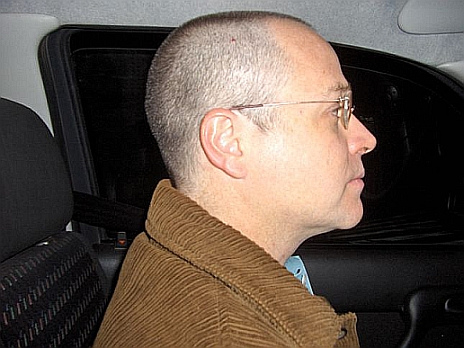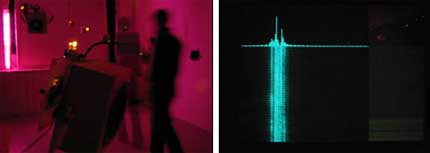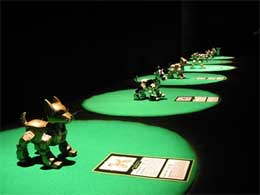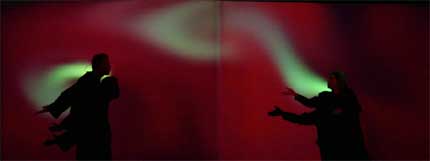 In its third edition, art.ficial emotion 3.0, the art and technology international biennial that will take place this Summer in Sao Paulo, associates the words “interface” and “cybernetics” to synthesize the idea of interactivity.
In its third edition, art.ficial emotion 3.0, the art and technology international biennial that will take place this Summer in Sao Paulo, associates the words “interface” and “cybernetics” to synthesize the idea of interactivity.
As the organisers write: “But, what does “interface” mean? And “cybernetics?” Basically, the former represents any surface which separates two systems, while the latter is a discipline that studies how the referred systems communicate and interact with each other.
If interactivity can be freely defined as a reciprocal relationship between two systems through an interface, just like it happens in the interaction between humans and machines or between machines and other machines, then the works selected for the exhibition perfectly fit within the theory of cybernetics.”
(…)
The works selected “embody concepts which are important to cybernetics, such as feedback, communication, causality, information, observation, predictability and equilibrium.
The line-up of the event is simply amazing:
France Cadet’s Dog[LAB]01, Eden by Jon McCormack, Life Writer by Christa Sommerer and Laurent Mignonneau, Messa di Voce by Golan Levin and Zachary Lieberman, Les Pissenlits by Edmond Couchot and Michel Bret, Marius Watz‘ Neon Organic 2, Text Rain by Camille Utterback and Romy Achituv, La Funambule Virtuelle by Marie-Hélène Tramus and Michel Bret, David Rokeby‘s Cheap Imitation, Daniel Rozin’s Software Mirrors, Evolving Sonic Environments by Usman Haque and Robert Davis, Talysis 2 by Paul Prudence, The Thoughtbody Environment Interface by Bill Seaman.
When Guilherme Kujawski wrote me about the festival, i asked him if he had time to waste on an interview. Seems to have turned into my main hobby: spamming people with requests for an interview!
 Evolving Sonic Environment
Evolving Sonic Environment
What’s your background? and your role in the festival?
I’m a Brazilian tech journalist and sci-fi writer. I have been working in Itaulab for 3,5 years.
I also have a not much updated blog which could give you more hints about me.
Well, inspired by conversation with some artists we came up with the theme of the show. So, technically, the curators are me and Marcos Cuzziol, game developer and Itaulab’s director. But we don’t think the term is correct. Actually, we like to say that the show was conceived by many people with several profiles, composed basically by the production team and an incredible asset of artists, researchers and scientists. It is accurate to say that this an “open source” show. At least, the “open source” philosophy was applied in the conception process.
Some circumstances that lies beyond the scope of the given e-mail has leaded us to work, at start, with a decentralized model, better saying, a “digital maoist” model, accordingly to a flashy terminology recently coined by a not so new and flashy guy (but of whom I regard my sincere respect). The theme is not gratuitous, because the exhibition committee, formed exclusively by the institute staff, has found support in a “self-reflexive loop” during the difficult decision of not calling a professional curator for the show.
So, the show was conceived and produced entirely in-house. Yet, many artists and scientists and poets and professors have given us a not committed conceptual support. Maybe this is the reason why I call this show the result of a “digital maoist” experience. Maybe we will be heavily chastised by this decision; maybe not.
The emocaoartificial event revolves around the term “cybernetic”. Why do you think a discussion about cybernetic is still so relevant today?
Well, I have passed through an “elevator test” other day. A colleague have asked me: “describe in few words the theme of your exhibition”. My answer: “the show is about interactivity’s foundations”. Cybernetics expresses itself by interactivity; and certainly it needs an interface to do that.
 DogLab
DogLab
Cybernetic exposes the inner working of interactions among humans, machines and their respective environments (in any order). As those relations are more and more present in our daily lives, I think cybernetic is also more and more relevant, since it gives us a way of understanding what is really happening.
Cybernetics is richer that we think. To have an idea, cybernetics relates with several other sciences – as artificial intelligence and the theory of the chaos -, and have defined terms that are widely spread out even in the daily language (“feedback”, for example). Unfortunately, people perceive just the prefix nowadays, thanks to William Gibson. The big plan of our show is demonstrate that cybernetics is much more than a prefix. It is a complete discipline that offers a new and sophisticated way to see how things work. I go further and say that cybernetics offers a new world view. Mainly the second order cybernetics, a variant that put the observer in the court. Our intent is passing this yearning through an art show.
I’ve been very impressed when i read the names of the artists participating to emocaoartificial. Why did you select these artists in particular? Did any particular reason guide the choice?
The choice was guided by the works themselves, specifically by their pertinence with the theme. The theme has prevailed. We have adhered strictly with it. The pieces should be absolutely interactive and create a kind of “loop” with the visitors. But we were not too paranoid, so we have two pieces that are not explicitly “cybernetics”. Bill Seaman‘s “The Thoughtbody Environment Interface” is just a DVD, but his powerful images and text refer to a imaginary “open order cybernetics”. And Marius Watz “Neon Organic 2” is a façade projection. It uses the building as an interface. The two demands a subtle reading.
 Neon Organic
Neon Organic
The festival has invited not only artists but also researchers to discuss with them. do you think artists and researchers dialogue enough outside such specially-organised events? What could they learn from each other?
I think the ever growing contamination between art and science is evidence that artists and scientists work increasingly together. In a way, the goals of both are similar, even though the methods are different. Perhaps mutual learning comes exactly from those differences, from different perspectives and methodologies for seeking similar goals.
We set up a symposium comprised of artists and researchers (or scientists). I truly believe that artists and scientists should invest more in “conspiracies” behind the scenes. This is the message we are trying to pass with our symposium. I think there is an optimal alchemy created with that kind of “mixology”. See, for instance, the collaborative work between Paul Pangaro & Usman Haque and Bill Seaman & Otto Rössler. Bill Seaman, for instance, has a whole work based upon the “benevolence machine”, a concept created by Otto Rössler. Usman Haque, by his turn, had the opportunity of recreate, thanks to Pangaro’s help, a device imagined by the most singular cyberneticist of all times, Gordon Pask.
How is the technological media art scene in Brazil? And in Sao Paulo in particular?
The technological media art scene in Brazil is taking off right now. There are several venues, as Emoção Art.ficial, FILE (Electronic Language International Festival) and Telemar Cultural Institute, with its punctuated exhibitions (in Rio de Janeiro). However the production of this kind of art are dispersed all over the country (Rio de Janeiro, Rio Grande do Sul, Pernambuco, Brasilia, mostly).
Which place is given to the local art scene in the festival?
This is a good question. There is no Brazilian artist in the show. This is because we did not find any Brazilian piece which fitted like a glove in the theme. As I’ve said before, we were very strict and restrictive in this matter. People could wonder if there is no “interactive” Brazilian piece. Yes, there is. But they were already exhibited recently in one of our shows.
 Messa di voce
Messa di voce
It’s the third edition of emocaoartificial. How has the event evolved over the years? How did the public react to the previous editions?
Please, take a look at the websites of the two previous editions:
Many visitors attended those shows. The average is 100 thousand visitors per show. There is one important detail. Emoção Art.ficial works with a schedule of three month. I don’t know of any other media art exhibition that offers this time frame. As you must infer, there are pros and cons.
How would you describe the relation between computer or electronic based art forms and the traditional art forms in Brazil?
I know of some traditional artists that have crossed this border. Regina Silveira, for instance. She is an artist who worked with Itaulab in “Descendo a Escada”. But this was not her first experience with art and technology. For more information about this piece, please take a look at Emoção Art.ficial 1.0 hotsite.
Can you give us the names of artists from Brazil whom you think deserve to be better known by an international audience?
You have already mentioned some of them in your blog, as Eduardo Kac and the duo Rejane Cantoni & Daniela Kutschat. There are many others. It would be unfair to mention just a few of them.
Thanks Guilhermo!
art.ficial emotion 3.0 roundtables and lectures take place on July 19, 20 and 21, in Sao Paulo, Brazil.
